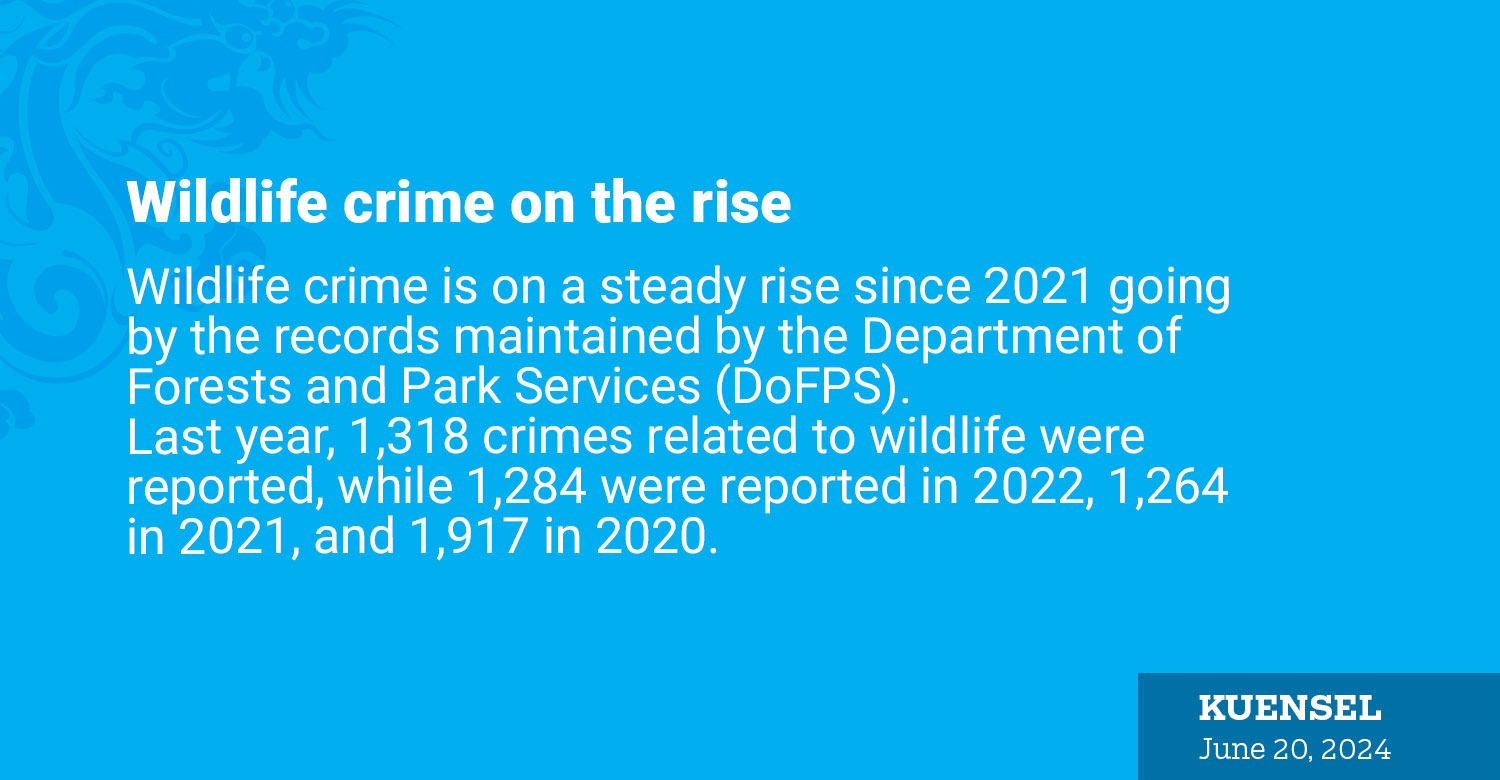Yangyel Lhaden
Wildlife crime is on a steady rise since 2021 going by the records maintained by the Department of Forests and Park Services (DoFPS).
Last year, 1,318 crimes related to wildlife were reported, while 1,284 were reported in 2022, 1,264 in 2021, and 1,917 in 2020.
The top three forest offenses recorded between 2020-2023 pertains to illegal timber extraction, illegal harvesting of non-wood forest products and illegal fishing.
Around 4,000 plant and animal species, with about 3,250 of them listed in the Convention on International Trade in Endangered Species (CITES) Appendices, were affected between 2015 and 2021 from seizure—confiscations of illegal wildlife—documenting illegal trade in 162 countries and territories.
Over the course of seven years, seizures involved 13 million items by number and over 16,000 tons by weight, according to the United Nations Office on Drugs and Crime’s World Wildlife Crime ( WWC) Report 2024.
The CITES Appendices are lists that classify species based on their conservation status and the level of protection they need and seizures
The WWC report states that illegal trade serves various end-use sectors, including food, medicine, live animal, and plant keeping, and luxury goods. Actual levels of wildlife trafficking are much higher than recorded seizures, with significant gaps in seizure-based evidence, particularly in sectors such as timber and fisheries.
The DoFPS has collected more than Nu 133M in fines for wildlife crimes between 2020 and 2023, with the top three being illegal timber (about Nu 94M), aquatic and fishing ( about Nu 6.7M), and timber misuse (about Nu 3M).
For the same period, fines of about Nu 2.1M were collected for illegal non-wood forest products, about Nu 1.9M for wildlife and poaching, and about Nu 5.3M for land-related offenses, among others.
A DoFPS official said that wildlife crime, including poaching and illegal trafficking had far-reaching impacts on the ecosystem and to the nation at large. “ Wildlife crime contributes to significant biodiversity loss, threatens ecosystem function with over-exploitation, risk of extinction of endangered species and risk of spread of zoonotic diseases.”
He said that wildlife crime yielded enormous profits for criminal networks, ranking alongside trafficking in drugs, arms, and humans which undermined investment in wildlife-friendly livelihoods such as ecotourism. “The crane festival, Rhododendron festival, numerous ecotourism programmes focused on wild flora and fauna would be impacted, if species in focus are poached to extinction, then tourist visiting the country will be reduced.”
Globally, wildlife crime is seen as one of the most lucrative crimes, run by sophisticated, international, and well-organised criminal networks. Since the crime is transborder in nature—poaching takes place in one country, transits through another, and is destined elsewhere—it is a global issue. The high rewards and low risks of the illegal wildlife trade stem from the freedom of flora and fauna to roam in the forest and the minimal investment required by offenders are seen as reasons why people commit wildlife crimes.
Despite gaps in knowledge about the full extent of wildlife trafficking and associated crime, there is sufficient evidence to conclude that it remains a significant global problem far from being resolved, the WWC report states.
The report calls for policy implications to combat wildlife crimes calling for continued commitment to coordinated action on wildlife crime with a focus on community engagement, investigative follow-up, corruption control, prosecutorial support, consumer demand reduction, and inter-agency cooperation, among others.
In the country, the DoFPS employs a comprehensive strategy to combat wildlife crime.
This includes capacity building through training programmes for frontline officials, collaboration with governmental and non-governmental organisations, and the establishment of the National Wildlife Crime Control Committee and institutional arrangements such as the National Zero Poaching Strategy and the use of advanced technologies like drones for monitoring.
“We operate within a robust legal framework and conduct extensive anti-poaching patrolling in hotspot areas which aims to address poaching, illegal wildlife trade, and human-wildlife conflict, ensuring sustainable conservation practices and adherence to international commitments and conventions,” the DoFPS official said.


